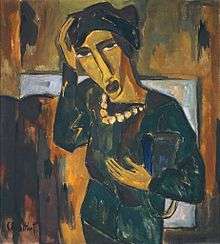Karl Schmidt-Rottluff

(mid 1910s)
Karl Schmidt-Rottluff (Karl Schmidt until 1905; 1 December 1884 –10 August 1976) was a German expressionist painter and printmaker; he was one of the four founders of the artist group Die Brücke.
Life and work
Schmidt-Rottluff was born in Rottluff, nowadays a district of Chemnitz, and was called Karl Schmidt until 1906. He attended the humanistische gymnasium (classics-oriented secondary school) in Chemnitz.[1] He began to study architecture in Dresden but gave up after a term[1] when he became one of the founders of the group Die Brücke ("The Bridge"), along with his fellow architecture students Ernst Ludwig Kirchner, Fritz Bleyl and Erich Heckel. The group was founded in Dresden on 7 June 1905, and its first exhibition opened in Leipzig in November of the same year.

In 1906 he added "Rottluff" to his surname. He spent the summer of that year on the island of Alsen, in the company of Emil Nolde. From 1907 to 1912 he spent the summers on the coast at Dangast, near Bremen. In December 1911, he and the other members of Die Brücke moved from Dresden to Berlin.[1] The group was dissolved in 1913. He served in the army on the eastern front from 1915–18 before returning to Berlin, where he spent the rest of his life along with his wife, Emy Frisch, except for a period during the Second World War, when he returned to Rottluff following the destruction of his studio in an air raid.[1] In 1924 the art historian Rosa Schapire who had been a long-time supporter, and sometimes model, published a catalogue of Schmidt-Rottluff's graphic works.[2]
The honours bestowed on Schmidt-Rottluff after World War I, as Expressionism was officially recognized in Germany, were taken away from him after the rise to power of the Nazis. He was expelled from the Prussian Academy of Arts in 1933, two years after his admission.[3]
In 1937, 608 of Schmidt-Rottluff's paintings were seized from museums by the Nazis and several of them shown in exhibitions of "degenerate art" ("Entartete Kunst"). By 1941 he had been expelled from the painters guild and forbidden to paint.
After the war, in 1947, Schmidt-Rottluff was appointed professor at the University of Arts in Berlin-Charlottenburg, through which he again exercised an important influence on a new generation of artists. An endowment made by him in 1964 provided the basis for the Brücke Museum in West Berlin, which opened in 1967 as a repository of works by members of the group.[3]
He was a prolific printmaker, with 300 woodcuts, 105 lithographs, 70 etchings, and 78 commercial prints described in Rosa Schapire's Catalogue raisonné.
He died in Berlin in 1976.
Collections
Schmidt-Rottluff's works are included in the collections of, among others, the Museum of Modern Art, New York; the Neue Galerie, New York; the Los Angeles County Museum of Art. The Museum am Theaterplatz in Chemnitz has a large collection of work from Schmidt-Rottluff.[4]
In 2011, the Neue Nationalgalerie returned two paintings by Schmidt-Rottluff, a 1920 self-portrait and a 1910 landscape titled Farm in Dangast, to the heirs of Robert Graetz, a Berlin businessman who was deported by the Nazis to Poland in 1942. A German government panel, led by former constitutional judge Jutta Limbach, had previously ruled that the loss was almost certainly a result of Nazi persecution and the paintings should be returned.[5] Schmidt Rottluff's esteemed Self Portrait with Monocle is now currently in the Staatliche Museum.
Art market
In 1997, £925,500 was paid for Schmidt-Rottluff's Dangaster Park (1910) at Sotheby's in London.[6] At a 2001 Phillips de Pury auction, British art dealer James Roundell bought Schmidt-Rottluff's The Reader (1911) for $3.9 million.[7] The top price ever paid at auction for a work by Schmidt-Rottluff was almost $6 million for Akte im Freien – Drei badende Frauen (Outdoor Nudes – Three Bathing Women) (1913) at Christie’s in London in 2008.[5]
See also
- Letter from Adolf Ziegler about the Nazi seizure of work.
- Departure from the Akademie der Künste
Notes and references
- 1 2 3 4 Carey, Frances; Griffiths, Anthony (1984). "Karl Schmidt-Rottluff". The Print in Germany 1880–1933. London: British Museum Publications. p. 123. ISBN 0-7141-1621-1.
- ↑ "Schapire, Rosa". Dictionary of Art Historians.
- 1 2 Karl Schmidt-Rottluff Museum of Modern Art, New York.
- ↑ Elizabeth Zach (July 27, 2012), In Germany, an Unlikely Art Hub Honed by Enthusiasm New York Times.
- 1 2 Catherine Hickley (November 18, 2011), Berlin Will Return Paintings to Auschwitz Victim’s Heir Bloomberg.
- ↑ Souren Melikian (October 25, 1997), Great Substitution Game Generates High Stakes and Huge Profits International Herald Tribune.
- ↑ Carol Vogel (November 6, 2001), First Art Auction of Season Indicates a Healthy Market New York Times.
External links
 Media related to Karl Schmidt-Rottluff at Wikimedia Commons
Media related to Karl Schmidt-Rottluff at Wikimedia Commons Quotations related to Karl Schmidt-Rottluff at Wikiquote
Quotations related to Karl Schmidt-Rottluff at Wikiquote